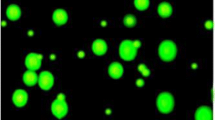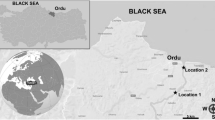Abstract
Genotoxic potential of herbicide bispyribac-sodium was evaluated in fish Clarias batrachus using micronucleus (MN) test and comet assay. Fish were exposed to three environmentally relevant test concentrations of the herbicide for 20, 25 and 30 days. Significant effects (p < 0.05) for both concentration and duration of exposure were observed in herbicide exposed fish. Similar trend of DNA damage was observed through MN test and comet assay. Maximum DNA damage was observed in fish exposed to highest concentration of herbicide at all duration. Maximum damage was observed on day 25 at all concentrations followed by a decline. This study established C. batrachus as an ecotoxicological model for bispyribac-sodium induced genotoxicity testing. It further confirmed that both MN test and comet assay are useful tool for assessment of genotoxicity induced by water pollutants.


Similar content being viewed by others
References
Ahmad I, Ahmad M (2016) Fresh water fish, Channa punctatus as a model for pendimethalin genotoxicity testing: a new approach toward aquatic environmental contaminants. Environ Toxicol 31(11):1520–1529
American Public Health Association (2012) Standard methods for the examination of water and waste water. APHA, Washington
Bombail V, Aw D, Gordon E, Batty J (2001) Application of the comet and micronucleus assays to butter fish (Pholis gunnellus) erythrocytes from the Firth of Forth, Scotland. Chemosphere 44:383–392
Eaton DL, Gilbert SG (2008) Principles of toxicology. In: Klaassen CD (ed) Casarett & Doull’s toxicology: the basic science of poisons. McGraw-Hill Medical, New York
Fairbairn DW, Olive PL, O'Neill KL (1995) The comet assay: a comprehensive review. Mutat Res 339:37–59
Fernando GKAW, Jayakody S, Wijenayake WMHK, Galappaththy GNL, Yatawara M, Harishchandra RDJ (2018) Assessing the nuclear level impacts upon exposure to Bispyribac–sodium and Carbosulfan in Poecilia reticulata and Aplocheilus parvus. Sri Lanka J Aquat Sci 23(1):85–93
Fenech M (2000) The in-vitro micronucleus technique. Mutat Res 455:81–95
Finney DT (1971) Probit analysis. Cambridge University Press, Cambridge
Gilliom R (2007) Pesticides in US streams and groundwater. Environ Sci Technol 41:3408–3414
Guilherme S, Santos MA, Gaivão I, Pacheco M (2015) Genotoxicity evaluation of the herbicide Garlon(®) and its active ingredient (triclopyr) in fish (Anguilla anguilla L.) using the comet assay. Environ Toxicol 30(9):1073–1081
Guilherme S, Gaivão I, Santos MA, Pacheco M (2010) European eel (Anguilla anguilla) genotoxic and pro-oxidant responses following short-term exposure to Roundup-a glyphosate based herbicide. Mutagen 25(5):523–530
Gupta P, Verma SK (2020) Impacts of herbicide pendimethalin on sex steroid level, plasma vitellogenin concentration and aromatase activity in teleost Clarias batrachus (Linnaeus). Environ Toxicol Pharmacol 75:103324
Hulbert AJ, Pamplona R, Buffenstein R, Buttemer WA (2007) Life and death: metabolic rate, membrane composition, and life span of animals. Physiol Rev 87:1175–1213
Kumar R, Nagpure NS, Kushuwaha B, Srivastava SK, Lakra WS (2009) Investigation of the genotoxicity of malathion to freshwater teleost fish Channa punctatus (Bloch) using the micronucleus test and comet assay. Arch Environ Contam Toxicol 58:123–130
Kim G, Clarke C, Larose H, Tran H, Haak D, Zhang L, Askew S, Barney J, Westwood J (2017) Herbicide injury induces DNA methylome alterations in Arabidopsis. Peer J 7:3560
Lajmanovich RC, Junges CM, Attademo AM et al (2013) Individual and mixture toxicity of commercial formulations containing glyphosate, metsulfuron-methyl, bispyribac-sodium, and picloram on Rhinella arenarum tadpoles. Water Air Soil Pollut 224:1404
Lee RF, Steinert S (2003) Use of the single gel electrophoresis/comet assay for detecting DNA damage in aquatic (marine and freshwater) animals. Mutat Res 544:43–64
López González EC, Larriera A, Siroski PA, Poletta GL (2017) Micronuclei and other nuclear abnormalities on Caiman latirostris (broad-snouted caiman) hatchlings after embryonic exposure to different pesticide formulations. Ecotoxicol Environ Saf 136:84–91
Madle S, Korte A, Ball R (1987) Experience with mutagenicity testing of new drugs: view point of a regulatory agency. Mutat Res 182:187–192
Martins M, Costa PM (2017) The comet assay in aquatic (eco) genotoxicity using non-conventional model organisms: relevance, constrains and prospects. In: Larramendy ML (ed) Ecotoxicology and genotoxicology: non-traditional aquatic models. The Royal Society of Chemistry, Cambridge
Mitchelmore CL, Chipman JK (1998) DNA strand breakage in aquatic organisms and the potential value of the comet assay in environmental monitoring. Mutat Res 399:135–147
Moreno NC, Sofia SH, Martinez CB (2014) Genotoxic effects of the herbicide Roundup Transorb and its active ingredient glyphosate on the fish Prochilodus lineatus. Environ Toxicol Pharmacol 37(1):448–454
Nagpure NS, Kumar R, Kushwaha B, Singh PJ, Srivastava SK, Lakra WS (2007) Genotoxicity assessment in fishes; a practical approach. NBFGR, Lucknow
Nwani CD, Nagpure NS, Kumar R, Kushwaha B, Lakra WS (2013) DNA damage and oxidative stress modulatory effects of glyphosate based herbicide in freshwater fish Channa punctatus. Environ Toxicol Pharmacol. https://doi.org/10.1016/j.etap.2013.06.001
Organization for Economic Cooperation and Development (1992) Guideline for the testing of chemicals: fish, acute toxicity test, document 203. OECD, Paris
Piancini LDS, Guiloski IC, de Assis HCS, Cestari MM (2015) Mesotrione herbicide promotes biochemical changes and DNA damage in two fish species. Toxicol Rep 22(2):1157–1163
Reinecke SA, Reinecke AJ (2004) The comet assay as biomarker of heavy metal genotoxicity in earthworms. Arch Environ Contam Toxicol 46:208–215
Rodrigues BN, Almeida FS (1998) Guia de herbicidas. Londrina, Agris
Rubach MN, Crum SJH, Van den Brink PJ (2011) Variability in the dynamics of mortality and immobility responses of freshwater arthropods exposed to Chlorpyrifos. Arch Environ Contam Toxicol 60:708–721
Ruiz de Arcaute C, Soloneski S, Larramendy ML (2016) Toxic and genotoxic effects of the 2,4-dichlorophenoxyacetic acid (2,4-D)-based herbicide on the Neotropical fish Cnesterodon decemmaculatus. Ecotoxicol Environ Saf 128:222–229
Singh NP, McCoy MT, Tice RR, Schneider EL (1988) A simple technique for quantitation of low levels of DNA damage in individual cells. Exp Cell Res 175:184–191
Toni C, Charlene C, Vania L, Bárbara E et al (2010) Oxidative stress biomarkers in Cyprinus carpio exposed to commercial herbicide bispyribac-sodium. J Appl Toxicol 30:590–595
Van der Oost R, Beyer J, Vermeulen NPE (2003) Fish bioaccumulation and biomarkers in environmental risk assessment: a review. Environ Toxicol Pharmacol 13:57–149
Wassom J (1992) Origins of genetic toxicology and the environmental Mutagen Society. Environ Mol Mutagen 14:1–6
Acknowledgements
The authors are thankful to Dr. Monika Bhadauria, Head of the department of Zoology for providing lab facilities.
Author information
Authors and Affiliations
Corresponding author
Ethics declarations
Conflict of interest
The authors declare that they have no conflict of interest.
Ethical Approval
The authors declare that all experiments carried out in this study comply with the current laws in India. Experiments were conducted in the department of Zoology, Guru Ghasidas University, Bilaspur (India) following all the safety regulations and ethical principles for animal welfare.
Additional information
Publisher's Note
Springer Nature remains neutral with regard to jurisdictional claims in published maps and institutional affiliations.
Rights and permissions
About this article
Cite this article
Pradhan, D., Singh, R.K. & Verma, S.K. Genotoxic Potential Assessment of the Herbicide Bispyribac-Sodium in a Fresh Water Fish Clarias batrachus (Linn.). Bull Environ Contam Toxicol 105, 715–720 (2020). https://doi.org/10.1007/s00128-020-03003-8
Received:
Accepted:
Published:
Issue Date:
DOI: https://doi.org/10.1007/s00128-020-03003-8




